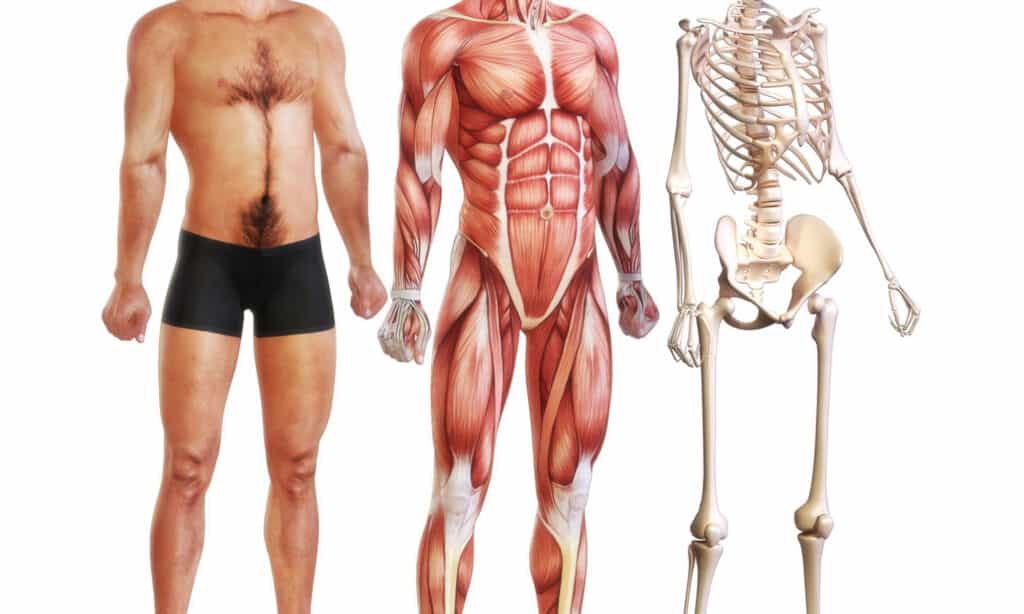The human body is a marvel about which we’re still learning. Organs are important parts of the body with various functions, from aiding in digestion to pumping blood around the body. These organs vary in size, too. Some of them, like the gallbladder, are about 4 inches long, and others are much longer. Today, we’re going to ask and answer, what is the largest organ in the body? You’ll see why this answer continues to be mired in controversy and speculation.
What is an Organ?

Organs are groups of tissue with a common purpose.
©Digital Storm/Shutterstock.com
Before we look at the largest organ in the body, we need to figure out what makes something an organ. By definition, organs are a collection of tissues that perform a specific function. For example, the stomach helps digest food.
Yet, the stomach is part of a collection of organs that acts to fulfill a common purpose. The stomach works in conjunction with the esophagus, intestines, and more to act as a more complex system, the digestive system.
For our purposes, we’re only going to look at one organ at a time rather than considering the entire system. Even this simplistic approach is wrought with some difficulty, as you will see.
What Is the Largest Organ in the Body?

The skin is the largest organ in the human body.
©TY Lim/Shutterstock.com
The skin is the largest organ in the body for humans. However, this answer is open to significant challenges, the least of which is the term “in the body.”
The skin is the largest organ in the body, measuring about 2 square meters or 20 square feet in size, and can account for up to 12% to 15% of a person’s overall body weight, over twice the weight of the brain. The skin is made up of three different layers. In order of outermost to innermost layers, they are the epidermis, dermis, and subcutis. The skin ranges in thickness from 0.02mm to 4mm thick. The thickest portions of the skin are located on areas of the body like the feet and buttocks.
The skin serves many different purposes. The skin protects against UV radiation from sunlight, heat injuries, physical injuries, bacteria, and other environmental contaminants. Also, the skin is important for helping to maintain a constant core temperature.
Furthermore, the skin helps synthesize vitamin D for use throughout the body, helps humans determine the ambient temperature, and provides a useful sense of touch. As you can see, the skin is a very valuable organ as well as being very large.
The skin is also part of a larger system called the integumentary system. This organ system includes the skin, hair, and various glands in the skin and nails. This system provides a valuable barrier between the internal and external environments. For example, the hair provides additional UV radiation protection on the head and body. Nails protect the sensitive fingers and toes.
However, some experts argue that the skin is not the largest organ in the body. Let’s take a look at other contenders for the largest organ in the body.
Could There Be a Larger Organ?

Bones or skeletal muscles could be the largest organs in the body.
©Life science/Shutterstock.com
Various arguments have emerged claiming that the skin is not the largest organ in the body. The skeleton is one of the most prominent options for the largest organ in the body. After all, bones do act like organs despite not always being considered organs.
Bones produce bone marrow, provide shape to the body, facilitate breathing, and allow human locomotion to occur in conjunction with the muscular system. If we consider bones to be organs and the entire skeleton an organ system, then the skeletal system is among the largest organs in the body. At any rate, it’s larger than the skin.
Yet, another organ could still be among the largest or the largest overall: skeletal muscle. Skeletal muscles are those muscles used for posture, movement, and breathing. Aside from making locomotion possible, these muscles also act as secretory organs. These muscles can make up about 35% of a person’s body weight!
The musculoskeletal system that includes skeletal muscles, bones, tendons, ligaments, and other connective tissues is the largest body system by weight and is very important to the human body.
Some would argue that the lack of overall connectivity between skeletal muscles and their somewhat individualized functions makes it so they should not be considered the largest organ.
A Newcomer Might Be the Largest Organ in the Human Body

Research is ongoing to determine if the interstitium is the largest organ.
©Anusorn Nakdee/Shutterstock.com
A new study claims that the largest organ in the body is a system of human tissue called the interstitium. The term ‘interstitium’ usually applies to places between the organs and muscles. The interstitium is various fluid-filled spaces that exist between internal structures such as organs, cell membranes, and more.
Now, the organ is believed to be an open, fluid-filled pathway that is supported by a network of collagen bundles that drains into the lymphatic system. Scientists only recently recognized that the interstitium could be considered a separate organ. Its purpose could be as simple as a shock absorber to protect other tissues. Specifically, it protects any part of the body that can expand or contract.
Advances in Probe-based Confocal Laser Endomicroscopy allowed researchers to get a better look at the interstitium. They found new levels of interconnectivity between these spaces. Not only is this significant because it is a new discovery that could help recognize a new organ, but it could also help explain how diseases like cancer spread.
However, the discussion of whether or not to consider the interstitium a new and separate organ is ongoing. More research is needed to confirm its function and see exactly where it exists in the body.
The conversation surrounding the largest organ in the human body is ongoing, complex, and filled with compelling arguments. For the sake of this article, we’re going to take the tried and true (and possibly wrong) assumption that the skin is the largest organ in the body.
At the very least, you should go forth with the knowledge that your body is a very complex system. Furthermore, science does not fully understand it just yet, and new discoveries are made all the time.
The photo featured at the top of this post is © restyler/Shutterstock.com
FAQs (Frequently Asked Questions)
How large are the kidneys?
The kidneys are a pair of organs that are each roughly the size of a human fist. Check out: The largest kidney stone ever recorded.
Thank you for reading! Have some feedback for us? Contact the AZ Animals editorial team.






